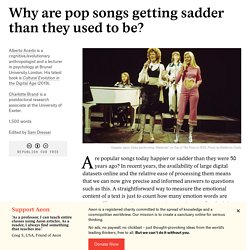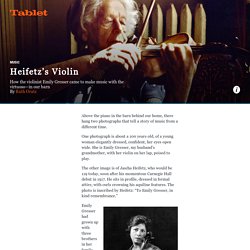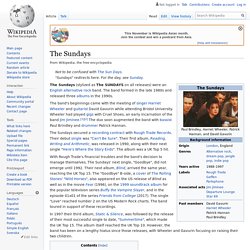

The Musical Trojan Horse: Destruction of Western Civilization through Music and the Arts. Did Beethoven Use a Broken Metronome When Composing His String Quartets? Scientists & Musicians Try to Solve the Centuries-Old Mystery. When it comes to classical composers, Beethoven was pretty metal.

But was he writing some kind of classical thrash? Hardcore orchestrations too fast for the average musician to play? Why are pop songs getting sadder than they used to be? Are popular songs today happier or sadder than they were 50 years ago?

In recent years, the availability of large digital datasets online and the relative ease of processing them means that we can now give precise and informed answers to questions such as this. A straightforward way to measure the emotional content of a text is just to count how many emotion words are present. How many times are negative-emotion words – ‘pain’, ‘hate’ or ‘sorrow’ – used? How many times are words associated with positive emotions – ‘love’, ‘joy’ or ‘happy’ – used? As simple as it sounds, this method works pretty well, given certain conditions (eg, the longer the available text is, the better the estimate of mood). The same technique can be applied to song lyrics. English-language popular songs have become more negative. The Music Barn, on Jascha Heifetz's Birthday. Above the piano in the barn behind our home, there hang two photographs that tell a story of music from a different time.

One photograph is about a 100 years old, of a young woman elegantly dressed, confident, her eyes open wide. She is Emily Gresser, my husband’s grandmother, with her violin on her lap, poised to play. The other image is of Jascha Heifetz, who would be 119 today, soon after his momentous Carnegie Hall debut in 1917. Meet Carol Kaye, the Unsung Bassist Behind Your Favorite 60s Hits. Carol Kaye: you may not recognize her name but chances are you're familiar with her work.

Now 81, the lady has laid down some deeply iconic bass tracks in a career spanning 55 years and something in the neighborhood of 10,000 recording sessions. How the Vietnam War Shaped Classic Rock. There are a handful of popular songs that have become cliche and shorthand for filmmakers wishing to take us back to the trauma of the Vietnam War: Jimi Hendrix’s cover of Dylan’s “All Along the Watchtower” or Edwin Starr’s “War,” to name two.

Yet at the same time, while classic rock lives forever, memories or lessons of Vietnam have not. Buffalo Springfield’s “For What It’s Worth” originally was a comment on the Sunset Strip Curfew (anti-war) riots, but now its meaning is open ended enough to suit any potentially violent protest. Watch the Sex Pistols Play a Gig on a Thames River Barge During the Queen's Silver Jubilee, and Get Shut Down by the Cops (1977) Getting your gig shut down by the cops is always excellent publicity--just ask the Beatles.

But there’s a world of difference between the 1969 rooftop concert and this June 7, 1977 boat party to publicize the Sex Pistols’ second single “God Save the Queen.” It shows how quickly the hippie dream of the ‘60s had curdled into the grim economics of mid-‘70s London, where race riots and police brutality, along with numerous national strikes, had made the UK fertile ground for the birth of punk. This film above, low in quality but a marked improvement over other versions circulating, is the longest documentation yet of the infamous and antagonistic trip. The Sex Pistols' Sid Vicious Sings Frank Sinatra's “My Way”: Is Nothing Sacred?
In the great garden of forking paths and alternative timelines there are two other versions of The Great Rock n’ Roll Swindle that Julian Temple never directed.

One would have been directed by Graham Chapman of Monty Python fame, but “he behaved gloriously badly to Malcolm (McLaren)” according to John Lydon many years later. These Boots Are Made for Walkin': The Story Behind Nancy Sinatra's Enduring #1 Hit (1966) You put on your bootsAnd I’ll put on mineAnd we’ll sell a million recordsAny old time- Lee Hazlewood Musicians!

Looking to increase your chances of a hit song, one that will worm its way into the public’s hearts and ears, earning fat royalty checks for half a century or more? Try starting with a killer bass line. According to singer Nancy Sinatra, songwriter Lee Hazlewood and arranger Billy Strange swung by her parents’ living room to preview a selection of tunes they thought she might want to record. The Sundays. The Sundays (stylized as The SUNDAYS on all releases) were an English alternative rock band.

The band formed in the late 1980s and released three albums in the 1990s. Brill Building. Office building in Manhattan, New York The building is 11 stories and has approximately 175,000 square feet (16,300 m2) of rentable area.

How Bob Dylan Made Rock History on 'Highway 61 Revisited' - Rolling Stone. Bob Dylan's second album of 1965, Highway 61 Revisited, would be a historic break: For the first time, none of the tracks would feature just him and his guitar. On May 10th, Dylan finished the brief tour of England – eight all-acoustic shows – chronicled in D.A. Pennebaker's documentary Don't Look Back. By now, he was bored playing his old songs as he'd recorded them. "I was playing a lot of songs I didn't want to play," he'd say afterward. 1 Song On Your Birthday.
Jazz Music By the Decade. Jazz has always had an undeniable impact on culture, yet a tumultuous relationship with popular music. At one point in the middle of the 20th century, the genre was at the forefront. It had pop stars. Miles Davis, with his constant, sometimes puzzling musical innovation and penchant for performing with his back to the crowd, was the genre’s Kanye West. Wynton Marsalis, with his cocksure commitment to “pure music,” was an analogue to Dave Grohl. John Coltrane’s religious dabbling brings up Madonna. Then, through the ’80s and ’90s, jazz seemed to lose direction, thanks in part to Kenny G, who let “jazz” mean music that’s more like bastardized adult contemporary pop-rock.